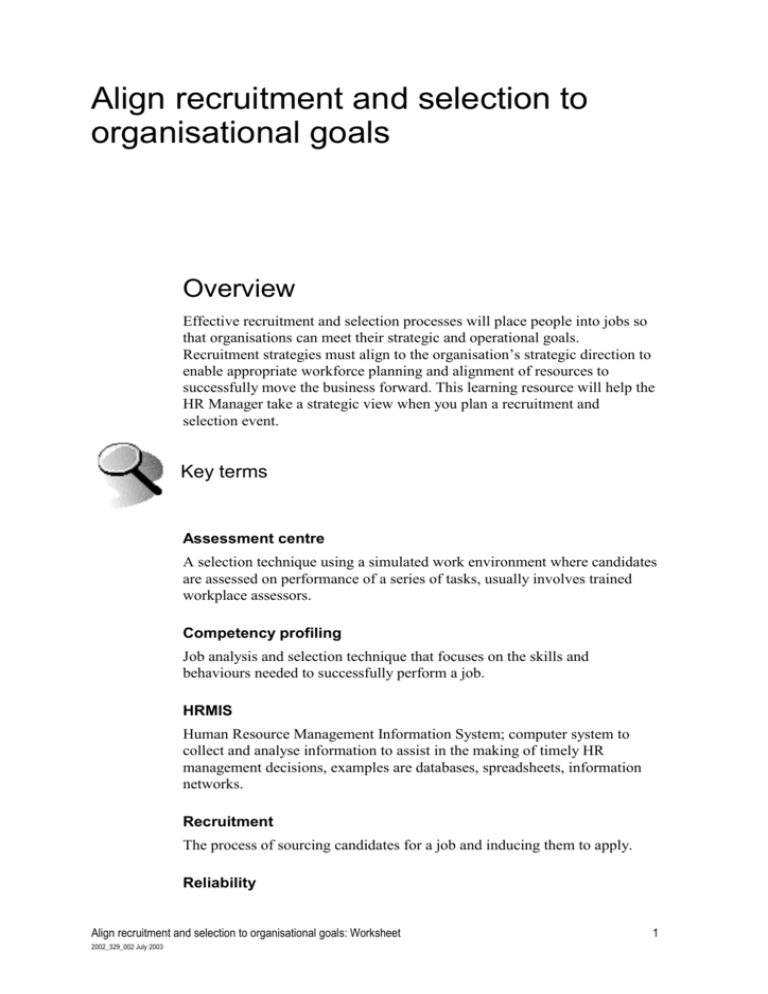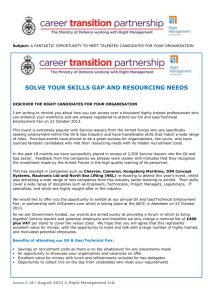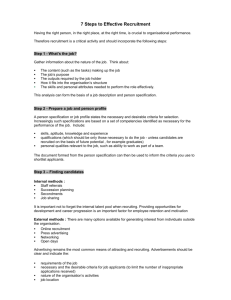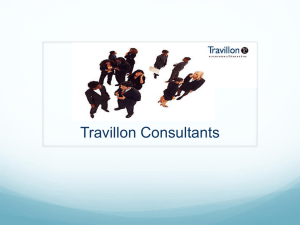Recruitment worksheet
advertisement

Align recruitment and selection to organisational goals Overview Effective recruitment and selection processes will place people into jobs so that organisations can meet their strategic and operational goals. Recruitment strategies must align to the organisation’s strategic direction to enable appropriate workforce planning and alignment of resources to successfully move the business forward. This learning resource will help the HR Manager take a strategic view when you plan a recruitment and selection event. Key terms Assessment centre A selection technique using a simulated work environment where candidates are assessed on performance of a series of tasks, usually involves trained workplace assessors. Competency profiling Job analysis and selection technique that focuses on the skills and behaviours needed to successfully perform a job. HRMIS Human Resource Management Information System; computer system to collect and analyse information to assist in the making of timely HR management decisions, examples are databases, spreadsheets, information networks. Recruitment The process of sourcing candidates for a job and inducing them to apply. Reliability Align recruitment and selection to organisational goals: Worksheet 2002_329_002 July 2003 1 An assessment technique is reliable if it delivers consistent results when used over repeated instances. Selection The process of identifying the best available candidate for a job. Validity An assessment technique is valid if it delivers accurate information on candidates related to specific selection criteria. People in recruitment and selection There may be a range of internal staff involved with recruiting, selecting, and inducting new employees into the organisation, and as the HR Manager it is your responsibility to coordinate and support the activities of these staff. They may include: administration staff HR officers or external consultants line managers, supervisors, team leaders workplace trainers. Senior management will need to have an overview of your employment activities, eg, you may trends and results in the form of periodic HRMISgenerated reports. Other people who you involve in your recruitment strategy may include: recruitment agencies specialists (internal or external) in areas like technology, operational functions, production, OH&S and training and development. You should factor in the human resources you need when developing the budget for your recruitment proposal. Technology in recruitment and selection There is a whole world of technology available to you, which will improve the efficiency and effectiveness of your employment practices. HRMIS (Human Resource Management Information Systems) can provide an employment information system for collecting and analysing data. This data can be translated, for example, into statistics on applicants and potential 2 Align recruitment and selection to organisational goals: Worksheet 2002_329_002 July 2003 applicants, on successful and unsuccessful recruitment and selection results, and induction outcomes. You can access reports on issues pertinent to where and how you recruit and select staff — reports for example of EEO cases, industry results, demographics, and labour market trends. HRMIS have many other facilities that will assist you when you are employing staff — facilities such as payroll administration, performancebased benefits schemes, training and development, performance assessment, and occupational health and safety planning. Databases, spreadsheets, word processing, desktop publishing, and web site development all provide the opportunity for you to improve and expand your recruitment and selection activities and induct new employees You should factor in your use of HRMIS when developing the budget for your recruitment proposal. Research Is HRMIS used for recruitment and selection in your organisation? If not, how could it be? What are the risks when recruiting staff? An organisation’s business performance relies heavily on having the right human resource capability to support the business needs and the recruitment and selection function is the first step in achieving this. Potential financial and business risks are associated with performing this key strategic human resource strategy and these can emerge throughout the process from sourcing potential candidates through to the negotiation of the employment contract. Costs to an organisation from a financial and business performance perspective can be quite high if a poor selection is made. For example, poor selection decisions can result in absenteeism, employee turnover, work related accidents and higher training costs. Align recruitment and selection to organisational goals: Worksheet 2002_329_002 July 2003 3 Misleading communications regarding employment contract provisions can result in the loss of a desired candidate and potential claims for redress through industrial mechanisms. To minimise the risks organisations need to: design and implement credible and transparent recruitment and selection frameworks and processes; ensure compliance with anti discrimination legislation throughout the process; select the most appropriate method/s for sourcing potential candidates; select assessment methods and tools appropriate for predicting the required performance outcome for the position; and ensure that verbal communications are clear throughout the process including the provision of documented evidence to support discussions held wherever appropriate. The recruitment and selection function should also have measures in place to evaluate performance in relation to the time taken to fill vacancies; the costs associated with conducting the process internally/externally; and quality of candidate selection and retention. Finding the right candidates Many methods are available to organisations to source internal and external candidates including: internal job advertisements in bulletins and on the intranet; external advertisements in the media including the radio and newspapers, professional industry journals and publications; via the internet on a specific job site or on an organisation’s web site; employee referral and applications received through the mail; and through professional organisations and educational institutions. Outsourcing Organisations may also seek the assistance of external providers including executive search firms and private recruitment agencies to complete the whole recruitment and selection process from sourcing candidates to final selection and referral. External providers are selected for a number of reasons including: 4 Align recruitment and selection to organisational goals: Worksheet 2002_329_002 July 2003 their expertise in managing the process as it is their core business, their available database of candidates in the external business operating environment and ability to respond quickly if a suitable candidate available; their replacement guarantee if a successful candidate leaves within a certain period of time; and to shift the responsibility to an independent source. But there are also disadvantages: external provider costs can be high, and external providers may not have a full understanding of the internal operating environment and culture of your business, and this may prevent real business needs being addressed. You need to consider these advantages and disadvantages before outsourcing recruitment and selection. Which method to choose? All methods discussed above for sourcing internal and external candidates can achieve the required result of filling vacant positions in an organisation. When choosing a selection method organisations will need to consider: strategic business implications, and the advantages and disadvantages of each method. The following table provides some comparative examples. Table 1: Advantages & disadvantages of recruitment methods (3 cols) Method Internal advertising (intranet and bulletins) External advertising Advantages Sources candidates who have a proven work performance record within the organisation which may save time and costs associated with retraining Promotes a culture of internal promotion which may lead to higher employee morale and sustained business performance Reaches a wider Align recruitment and selection to organisational goals: Worksheet 2002_329_002 July 2003 Disadvantages Places limitations on sourcing candidates who may have a higher level of capability to meet the business needs May result in employee promotions beyond capability levels impacting on individual and business performance May impact on 5 Method Advantages audience in the external business operating environment (newspapers and radio) Internet Disadvantages Assists in attracting a more culturally diverse candidate pool for assessment purposes which may also align to the organisation’s EEO Strategy Achieves local and global business exposure and presence Sources candidates with external and global experience that may add value in terms of business delivery achieving business objectives due to time involved to source and induct new employee May impact internal employee morale and result in achieving a wrong cultural fit May increase the time and costs associated with sourcing and selecting candidates May result in additional costs to the business including relocation expenses and delays in transition Employee referral May attract candidates who fit from a cultural perspective as like attracts like particularly successful where current employee is the right fit Can lead to nepotism and breaches of policy and procedural guidelines and staff dissatisfaction with the recruitment and selection process Professional industry journal Targets specific professional groups that you want to attract into the organisation Timelines to advertise are usually monthly or quarterly Established recruitment policies and procedures may also outline conditions for selecting appropriate methods for sourcing potential candidates. Existing policies and procedures must be consulted and adhered to where they are explicit in this area and when making selections. 6 Align recruitment and selection to organisational goals: Worksheet 2002_329_002 July 2003 Processes to ensure legal and policy compliance Consider this email of complaint from an unsuccessful job candidate: From: Gus Tinsdale Sent: Wednesday 6:30 pm To: Bettina Rusque, HR Officer Subject: YOUR RUDE LETTER Dear Ms Rusque I was most disappointed to receive your letter informing me that I was not to be offered an interview for the shift supervisor position, and that you would not discuss the matter further. The tone of your letter suggests to me that STAR is attempting to cover up questionable, or even illegal, recruitment practices. Indeed the fact that you will not discuss applications or provide feedback is suspect. In particular, I am concerned about possible age discrimination. The selection documents did not mention age, although the advertisement said ‘youthful’. Moreover your Mr Perez told me on the phone that she was looking for a ‘young, dynamic team’. I assure you life begins at 40, and I regard myself as both young and with plenty of “youthful exuberance”, and I would like to know whether I have been refused an interview because you thought that I was too old. Yours sincerely Gus Tinsdale What went wrong here? It's clear that this organisation has not complied with legal requirements because: all dealings with candidates by members of the organisation during the recruitment and selection process must comply with both antidiscimination legislation and the EEO legislation the legislation prohibits discrimination on the basis of age, as well as, sex, race, religion, nationality and other non-work-related factors Align recruitment and selection to organisational goals: Worksheet 2002_329_002 July 2003 7 there is also an emerging area of law where family responsibilities is also a prohibited area. Think How would you ensure that all legal and organisational policy requirements are followed during the selection processes? Consider processes and checks you could put in place for placing job ads, protocols for interview, and protocols for communicating with candidates during the selection process. Assessment methods Assessment methods (ie methods to select the right candidate) will vary between organisations and will depend on whether the recruitment process is being undertaken internally or externally. The level and type of position to be filled will also determine the assessment methodology. The application form or resume will generally be the first insight into a candidate’s capability to meet the selection criteria. Initial assessment methods may include: telephone screening to determine whether the applicant can meet some of the essential criteria a brief preliminary interview to focus on specific job requirements the short listing of candidates against the selection criteria for further assessment Merit based selection Merit based selection means that the job candidate is assessed against clearly defined selection criteria. Merit based selections involve making an assessment of the candidate’s work related qualities aligned to those required for effective business performance. Work related qualities include: 8 Align recruitment and selection to organisational goals: Worksheet 2002_329_002 July 2003 skills and abilities, standards of work performance; qualifications; training and competencies. Clearly defined position descriptions including major areas of responsibilities, desired capabilities and selection criteria are essential and underpin this process. The position description also provides the context to assist in determining the appropriate assessment methods to screen and select candidates. Selection criteria examples: Knowledge of PC office applications Able to schedule multiple work teams Able to work collaboratively in a team Experience in operating XYZ equipment Proven ability in database troubleshooting Able to present a marketing proposal to a client Holds a class “L” or “N” operator’s licence Demonstrated ability to plan and manage project budgets Example: assessment of an applicant against selection criteria Using information from a written application or telephone screening, this applicant was assessed against the selection criteria, and rejected for further interviews. Table 2: Assessment sheet for applicant (2 cols) Position: Shift supervisor Applicant: Gus Tinsdale Essential criteria Assessment 1. Minimum of three years’ experience in production of windows, doors and related products 15 years’ manufacturing experience in various building-related industries 2. Ability to liaise with suppliers, other staff and management Yes 3. Ability to supervise and build a team, with well developed interpersonal and leadership skills No 4. Working knowledge of quality improvement systems and tools and be able to problem– solve and instigate process improvement strategies No 5. Extensive knowledge of stock control and production computer database programs Expert in stock control; recently completed a short course in database management Align recruitment and selection to organisational goals: Worksheet 2002_329_002 July 2003 9 Desirable criteria 6. Three years’ experience in production and stock control of window coverings No 7. Broad knowledge and interest in related products and services such as shower screens, home security systems, skylights Yes 8. Previous experience in managing and developing a self-directed team No 9. Tertiary qualifications in management and leadership No tertiary qualifications; no plans for study 10. Willingness to work in different plants as needed Yes, but prefers 2 weeks notice due to family commitments; appeared to be inflexible on this point 11. Willingness to work regular overtime As above Decision Do not interview; did not meet essential criteria 3 & 4, no tertiary qualifications, and may be unavailable to work away or work overtime at short notice. Think What would be the selection criteria for a job that you’re familiar with? It could be your own job, or another job within your industry Essential criteria Desirable criteria Assessment centres Assessment centres can provide an alternative for organisations to assess a larger pool of potential candidates at the one time. This method involves the administration of a number of activities including: 10 group discussions to resolve a particular business problem which may include financial performance or change management; Align recruitment and selection to organisational goals: Worksheet 2002_329_002 July 2003 a series of interviews conducted by a number of people from the organisation; role playing and group decision making; and the completion of a psychological test pertinent to the position/s to be filled. Assessment centres can be expensive to run due to the various associated costs which may include: the hiring of the venue; the high level of expertise required to evaluate outcomes; and the array of various activities required to conduct the process effectively. However, the use of assessment centres provides a viable opportunity to assist organisations with volume recruitment and when time is an essential performance indicator to meet business delivery objectives. Research also suggests that assessment centres provide more reliable and valid outcomes due to the various assessment methods and tools used. Assessment tools The use of assessment tools and tests has increased in Australia recently as organisations search for additional methods to attract and retain the right candidates. The decision to use assessment tools will be driven by an organisation’s recruitment and selection policy and usually precedes the selection interview process. The appropriate application of these tools can increase the validity and reliability of selection decisions and provide data to support selection outcomes. Reliability and validity Essentially, a systematic selection process, which looks at reliability and validity factors, makes a better connection between selection criteria and job performance predictors. For example, tests may be conducted to predict how a candidate will perform in relation to specific selection criteria, which may include a high level of ability to sell products. The predictor of job performance will be the score outcome and level achieved related to the selection criteria - ability to sell products. Data is reliable, if consistent results are achieved by the same candidate in the same set of circumstances. A wide range of objective assessment tools and materials are available to help achieve a better match between candidates and positions. Specific tools may be used where a cultural shift is required and where an organisation needs to lift their capability in the area of customer service delivery for example. The following table lists advantages and disadvantages of various assessment tools: Align recruitment and selection to organisational goals: Worksheet 2002_329_002 July 2003 11 Table 3: Advantages & disadvantages of assessment tools (3 cols) Assessment tool Aptitude test Advantages Can predict job performance in a number of areas which may include clerical work May be of value where the candidate has limited experience Can provide a good indication of a candidate’s ability to learn, conceptualise and problem solve tests special abilities required to perform a job Intelligence test designed to test a candidates IQ Personality test measures a candidate’s personality May be beneficial for managerial positions. May predict a candidates preferred personality style whether introvert or extrovert and level of motivation Disadvantages Candidate may get to know how to complete tests and answer as required Data may not be reliable Some tests may be culturally biased and limit access to potential candidates Scores may not be a good predictor of job performance May be difficult to draw definite conclusions as candidates can fabricate answers Assessment tools and tests must be conducted by a suitably qualified person who is either industry trained or accredited for this purpose and this may include an organisational psychologist. 12 Align recruitment and selection to organisational goals: Worksheet 2002_329_002 July 2003 Notifying successful applicants The offer letter must be worded carefully because under common law it will become part of the employment contract. There is also a lot of case law on how the conversations between successful candidate and the person making the appointment can also form part of an implied contract. This is particularly the case where the written offer or contract was inadequate, or was silent on a particular issue. Read Read about employment contacts: Woodward S. Michaelandos M, 'Employment Contracts' (2003) in Australian Master Human Resources Guide 2003, CCH, Sydney, Ch 11 Look for information on: types of contracts terms and implied terms of the contract preparing and presenting the contract. Align recruitment and selection to organisational goals: Worksheet 2002_329_002 July 2003 13








